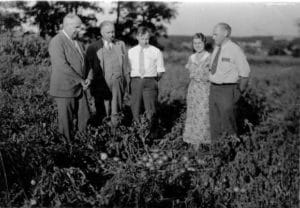The New York Times
by Valerie Sudol
 |
Source: Rutgers |
The Jersey tomato, red, ripe and juicy, was once revered as the best to be had, with a tangy, sweet-tart flavor that was the very taste of summer.
If that kind of tomato perfection has faded to a dim memory in recent decades, blame mechanized harvesting and long-distance shipping, which prize durability over flavor. Pulpy, thick-skinned, flat-tasting tomatoes became the unsatisfying norm.
“The old, soft tomatoes split too easily, so you couldn’t ship them,” John Hauser, a farmer in Old Bridge, N.J., said. “But newer tomatoes, while they look good and hold up well, made people start to understand that beauty is only skin-deep. A lot of flavor was lost.”
This season, Rutgers University introduced a reinvented version of a tomato variety from 1934 that reigned unchallenged for decades. After years of work by Rutgers plant specialists, this old-fashioned tomato with old-fashioned taste has returned as the Rutgers 250, named in honor of the university’s 250th anniversary.
“This was the tomato that made the Jersey tomato reputation,” Thomas J. Orton, a professor in the department of plant biology and pathology, said of the 1934 variety. “It was a groundbreaking tomato that redefined what a tomato should be and was the most popular variety in the world. At one point, it represented in excess of 60 percent of all tomatoes grown commercially.”
Indeed, the Rutgers 250 is so popular that some 5,000 packets of seeds made available to the public on the university’s website in February have already sold out. Then, last month, home gardeners snapped up 1,200 seedling plants in just two hours at a campus event in New Brunswick.
“I could have sold twice as many,” said William T. Hlubik, the Rutgers Cooperative Extension agent for Middlesex County who supervised seedling production for the sale. “There was huge interest in the genetics and how plant breeders developed the 250. This is a real retro tomato — history you can eat.”
Jim Giamarese of East Brunswick, N.J., who sells his crops at the Red Bank farmers market, said he would be growing the Rutgers 250 for the first time this season and had high hopes, given customer demand for other Rutgers varieties.
“I’ve got some customers who are hooked,” he said. “People appreciate the effort to recapture the traditional flavor of the famous New Jersey tomato. They’re looking for that old-time taste.”
Rutgers’s agricultural programs were once linked to Campbell Soup Company, which is based in Camden, N.J., and is one of the largest food companies in the world. Many of the most successful tomato varieties were the result of collaborations between Rutgers and Campbell Soup.
In 2007, when researchers at the New Jersey Agricultural Experiment Station, Rutgers’s research arm, set out to resurrect the flavorful Jersey tomato, they focused on varieties that were popular from 1950 to 1970. Despite falling out of favor with commercial farmers after being judged too soft and perishable for modern harvest and transport, they were still suitable for home and small-scale specialty growers.
“The picture changed dramatically in the 1960s with machine harvesting since the old varieties were too soft and turned into tomato juice,” Professor Orton said. “It took an entirely different, tougher and smaller tomato to undergo the rigors of the mechanical process. Tomatoes like Rutgers became obsolete instantaneously.”
The breakthrough came, Professor Orton said, when plant breeders learned in 2009 that Campbell Soup still had genetic material from the parent plants that was used to develop the original Rutgers hybrid. The chase was on — in slow motion.
The first-generation plants were “scraggly, weedy things that didn’t give us much hope,” said Professor Orton. He worked the test fields with Peter J. Nitzsche, the Rutgers Cooperative Extension agent for Morris County, and Jack Rabin, the associate director of the experiment station.
By 2013, researchers had narrowed the field to 14 selections and to five by 2014. Last year, three finalists were grown all over New Jersey and vetted at six tastings. Size, color, yield and disease resistance were evaluated, but flavor was the chief consideration.
“There’s a whole mystique about the Jersey tomato and it’s hard to say what makes it so much better,” Mr. Nitzsche said. “To me — to most people — it has to do with a balance of sweetness and acidity, but it’s partly subjective. This isn’t all pure science.”
Last November, the Rutgers 250 emerged the winner.
“People have had enough of tomatoes that don’t taste like much and have been demanding that we do better,” Professor Orton said.
The tomato project “was chasing something almost mythical,” he continued. “It wasn’t a sure thing, but we think we got lucky.”

